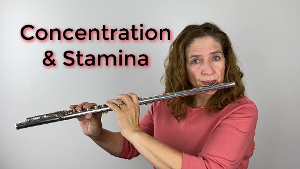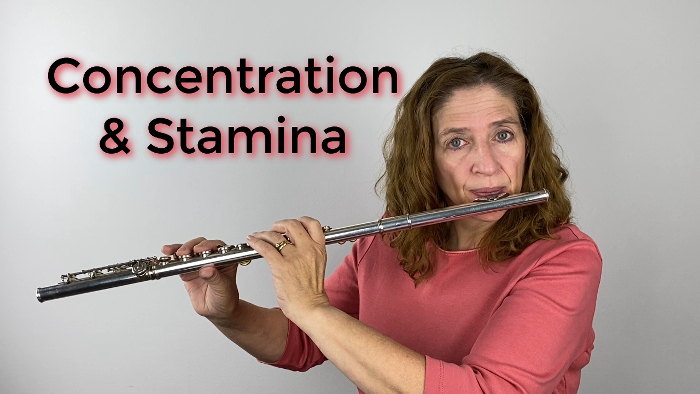Concentration and stamina are two areas of flute playing that we all need to work on. These are skills that you can learn. I know that I can work on those too. These are things that I’ve learned later in my performing and teaching career. They’re not something that I was brought up to know and I wish I had.
Let me give you a few pointers on what I wish I’d known in my younger years about how we can work on this area of performing. I used to think that it was really something that you just had to do. It was just a matter of willpower. And while it is a matter of willpower, there are ways that we can work on that self-control and that will, to achieve better results.
Know it Cold
One of the ways to work on this is to make sure that you know your piece cold.
Probably the first thing that I’ve had to learn in my career is to know a piece better than I think. Because the moment that you are nervous or the situation that you’re performing in is not optimal, then your concentration is affected. And if you don’t know your piece absolutely cold, then that’s going to invite disaster – flubs that you don’t necessarily need to have in your performance. But if you know your piece cold, you know the tempo, you know it faster than you want to play it, you know it slower than you want to play it, then you’re going to take that little bit out of the equation.
Play Through Difficult Spots
The second thing that I would say is learning to play through your difficult areas. And I mean, play through them. Oftentimes we take our difficult spots that cause us to flub up when we’re performing, and we just work on those flubs.
We do what I call the practice process which uses all the different articulations with your metronome on. I practice this way until I’ve learned that spot cold. But guess what? As soon as I do a play through with my piano player, that spot falls apart (at least it used to for me). The reason why that spot then falls apart, when I know it, I’ve learned it, I’ve done all the things that I need to do is because I haven’t learned mentally that I know it. So, in my mind, it still is a difficult area. What I must do is to erase the fact that that’s a difficult area from my brain and learn to play through that difficult spot without flubs. Then I will make new paths from my eyes to my brain, to my fingers saying, “oh no, it’s not a difficult spot anymore. I can play that spot.”
How Do I Play Through?
So, I learn to play through difficult spots. What this means is that I will add a measure before and a measure after the tricky spot – thus playing through it. However, you cannot start this until after you’ve done all your wood shedding, and you know that particular run or those particular measures that are tricky. Know them cold, then add a measure before and after. Then learn to play through.
Now you must play it through with your metronome on, because you don’t want to allow yourself the luxury of slowing down in those spots. When you have the metronome on it forces you to play through, hopefully up to tempo.
Plat at Tempo
And so I can put my metronome on the tempo and I can play the measure before the measure after, and I can play through that and I can do it again and again and again, and I can do it tomorrow with my flute cold, not having warmed up and I can play right through that spot because you’re teaching your brain a new path through that section because your brain learned the path that was wrong, that it was a flub area that you had problems now you have to learn that is not a problem area.
What you want to think about is that your brain no longer says, “that’s my tricky spot.” Your brain now says, “I’m just going to play because I know this piece, I can play it all the way through.”
Play Through a Section
After you’ve done that, played through with a measure before and a measure after, then I would go with a line above and a line after. Now you might want to say, well, what does it mean to play after? Because if I’ve gotten through that section successfully then I’m good right? Well, again, it’s teaching your brain how we think and how we learn. That section is no longer a problem. I no longer have to fear it and I’m going to erase that little niggly fear that comes in when I’m performing that says that’s a tricky spot.
Play Through a Page
Now’s the time where I might want to do the whole page. I want to play through the whole page with the metronome on. If you put that metronome on and you can play through that tricky spot, maybe another spot is revealed to you where you flub up and then you can mark that area and come back to it and start working on that. But it’s playing from top to bottom that is going to teach you how to concentrate all the way through and not allow yourself to have those flub areas. The areas that you’ve learned are tricky spots are more strongly erased and now we have no tricky spots.
Etudes Teach Concentration
Now the best place that I’ve learned to really work on that concentration and really stamina as well, meaning I can make it through a tough piece, keeping my brain on track and keeping my concentration is through etudes. The longer the etude the better. The Anderson etudes for example, get trickier and harder and more difficult as you go along. So, if you can make it through them concentrating, you can make it through a solo that will have measures of rest and places where you can put your arms down.
I am a big fan of etudes. But not just for technical skill and not just for learning music, but also because it really helps you to learn concentration and build stamina, when all the way through your metronome is on, you’re playing straight through. You are not allowing yourself to stop on those tricky spots because you’ve learned them and now your concentration is taking you through the whole piece.
Go get out a tricky etude and begin working on your stamina and concentration. It’s good work, it’s solid work, and you’ll be happy that you’ve done this kind of wood shedding and this kind of concentrated work.
Have fun!
DoctorFlute
Watch me demonstrate this idea:
Concentration and Stamina in Your Playing – FluteTips 162

